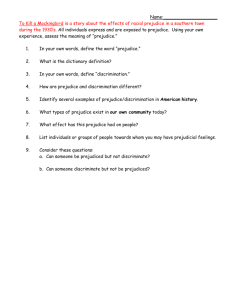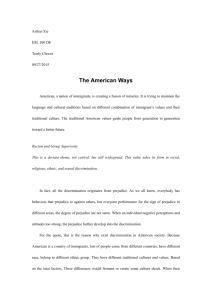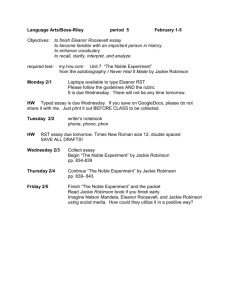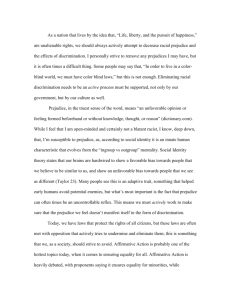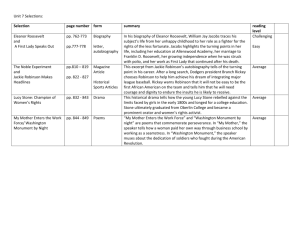art exhibition opening, march 1999
advertisement
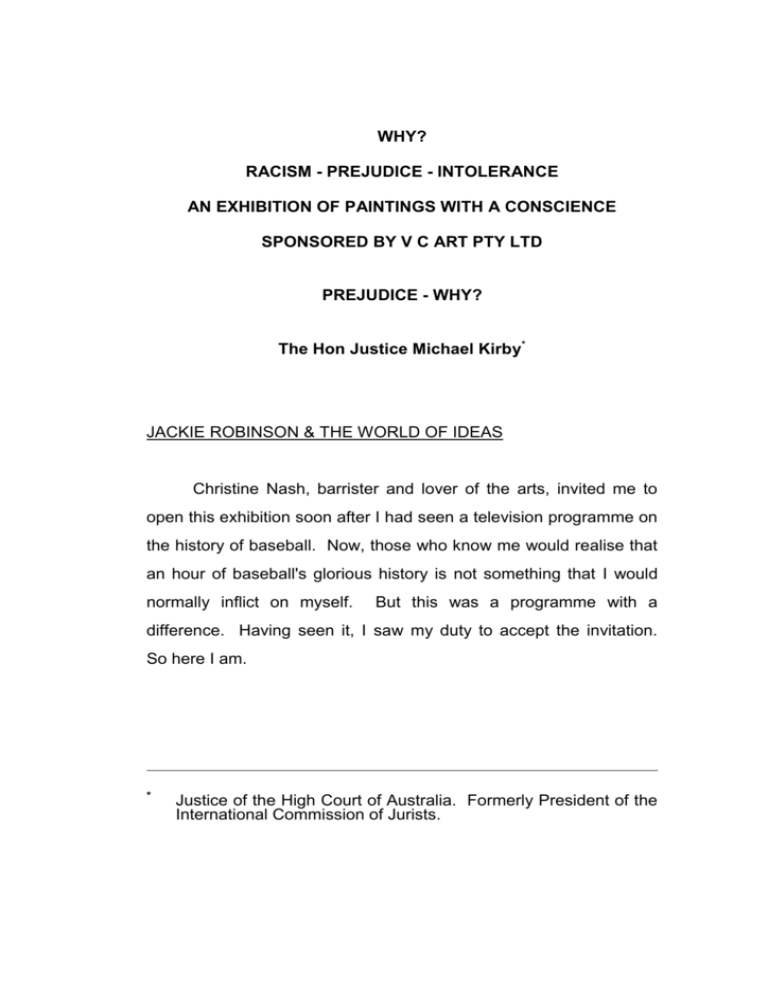
WHY? RACISM - PREJUDICE - INTOLERANCE AN EXHIBITION OF PAINTINGS WITH A CONSCIENCE SPONSORED BY V C ART PTY LTD PREJUDICE - WHY? The Hon Justice Michael Kirby* JACKIE ROBINSON & THE WORLD OF IDEAS Christine Nash, barrister and lover of the arts, invited me to open this exhibition soon after I had seen a television programme on the history of baseball. Now, those who know me would realise that an hour of baseball's glorious history is not something that I would normally inflict on myself. But this was a programme with a difference. Having seen it, I saw my duty to accept the invitation. So here I am. * Justice of the High Court of Australia. Formerly President of the International Commission of Jurists. 2. The programme told the story of Jackie Robinson. He was the young African American baseball player who literally broke the grip of racial segregation in baseball in the United States. In autumn 1945 he was signed up to play with the Montreal Royals by its Jewish President, Branch Rickey. It was a courageous step because, since the 1880s, not a single black American had played in top baseball. They had done so in the nineteenth century. But on a day in 1887 the Chicago White Stockings refused to play with the New York Giants who were fielding black players. By a 6-4 vote, the response of the Committee to this threat was to withdraw black players. Thereafter, for 50 years, baseball in the United States was played in segregated teams. When Jackie Robinson took the field in 1945, he was breaching this silent code of acquiescence. All eyes were upon him. As it happened, he was an inspired baseball player. His life was heaped with indignities. He was refused admission to restaurants and hotels when his team toured the South. He was off-loaded from planes and his ticket given to a white man. He was even forced to drink from separate bubblers at bus stops on the tour. Rickey told of how he took the young Robinson to his own hotel room, left him there and found himself another room. But when he returned to get something, he found Robinson quietly crying. This master of sport and heroic athlete was subjected to intolerable humiliation. There was no reason other than his race and skin colour. 3. Despite the necessities of enormous concentration involved in the game, the humiliations and cat-calls, the lack of understanding, Jackie Robinson stayed the course. He moved into the Major League in April 1947 with the Brooklyn Dodgers. He won the pennant as "Rookie of the Year" for the 1947 season. More importantly he won the hearts of his fellow citizens. We, in Australia, have had sporting heroes who have taught us similar lessons of equality and forced us to confront racism, prejudice and intolerance in our own society. Yvonne Goolagong. Cathy Freeman and many other great Aboriginal athletes. And in the field of discrimination against homosexual citizens, the football player Ian Roberts. Such heroes carry extra burdens. Like Jackie Robinson, it is not only the individual who is judged but those whom the individual is taken to represent1. IDEAS AND THE PROCESS OF REFORM The impact of ideas upon the change of the law and of attitudes in society cannot be overstated. This is why an exhibition such as this is so important. It presents the beauty of art. But it also 1 J Tygiel, Baseball's Great Experiment. Jackie Robinson and His Legacy, 1983, OUP, New York, 328. 4. offers symbols and images which are designed to shock, puzzle and persuade. To measure the impact of the idea of Jackie Robinson - a black man on a field of white faces - one must go back to those times. The United States of the 1940s was a segregated society. Racial segregation was widely accepted as legitimate. The outburst of empathetic feeling for Jackie Robinson in 1947 probably had an effect on President Truman's announcement in July 1948 that he was ordering the end to racial segregation in the United States military forces. Until that executive order the American Armed forces were segregated into all white and all black units. The 1948 order took more than two years fully to implement2. Similarly, in July 1948, when Jackie Robinson was well on his way to establishing that his first season had been no fluke, Truman announced the appointment of a Committee on Civil Rights to investigate violations of the rights of black Americans and to recommend remedial legislation. This was the step that began the process that led to the Civil Rights Acts of 1957 and 1964 and the Voting Rights Act of 1965 in the United States. Jackie Robinson played an important part in supporting Presidents Eisenhower, 2 J G Hylton, "American Civil Rights Laws and the Legacy of Jackie Robinson" 8 Marquette Sports LJ 387 at 395. 5. Kennedy and Johnson in their endeavours to reform the law. The symbol of his work was tremendously potent. It is astonishing to us now to remember that in the United States, with its Revolution, Civil War, Bill of Rights and espousal of liberty, it was not until 1943 that the American Bar Association became other than, effectively, a "whites only" organisation. This fact had forced black lawyers in that country to form their own group, the National Bar Association3. The fact that lawyers, of all people, accepted racial discrimination in their professional organisations gives a clue to how endemic this feeling was in the United States. It was also endemic in Australia. Indeed, here, it was supported by laws and policies of national and State governments. The White Australia policy was enforced at the frontiers by the Federal Government and Federal Parliament. Discrimination against Aboriginal Australians was possibly implicit in provisions of the Constitution, not repealed until the referendum 1967. It was certainly explicit in laws, governmental policies and court decisions affecting the Aboriginal and Torres Strait Islander people of Australia. 3 J C Smith, Emancipation, The Making of the Black Lawyer (1993) 541. 6. PREJUDICE & ITS MANY FACES If I look back on my life as a lawyer and ask why prejudice and intolerance on the grounds of race, and other irrelevant causes, existed, and sometimes even flourished, in sunny Australia, the answer is found in the conduct of very ordinary people, otherwise good citizens. They acted out of habit, fuelled by ignorance, encouraged by lack of thought. When I think back on the work of the New South Wales Council for Civil Liberties in the 1960s, it was brave but it had a remarkably narrow view about civil rights. It was mostly concerned with suggested misuse of police power against middle class citizens. Not much was then done for Aboriginals, though their civil rights were often abused. Not a great deal was done for women and children, though they suffered many disadvantages in the law. Little attention was given to the specific problems of ethnic communities, though they were by then numerous. And absolutely nothing was done or said about gay and lesbian citizens and the savage legal discrimination which they suffered. That was a subject that dared not speak its name. We have made progress since those times. We recognise and have begun to redress, the wrongs done to Aboriginal Australians (sometimes with good intentions, sometimes not). We have begun the course of changing attitudes of prejudice to the rights of women and of children, so as to remove discrimination against them. We have provided racial discrimination laws and other protections for the ethnic communities which now enrich our society. 7. We have removed some of the discriminatory and prejudiced criminal sanctions on gay people; but in some parts of Australia (including New South Wales) serious discrimination remains. The politicians, now regaling us with their electoral promises, could not find the courage to remove discrimination from the statute book. Let us hope that the next Parliament acts by principle. We should ask ourselves of the other grounds of prejudice that exist today and dare not speak their name. Prejudice on the basis of HIV status. Prejudice on the basis of drug addiction. against the long-term unemployed. Prejudice Prejudice flourishes where people have no contact with those whom they hate or despise or fear. That is why an exhibition such as this, in a legal precinct, is so important. It is full of challenging ideas. Robyn Woodward has endeavoured to portray, in five panels of her major work, images of prejudice drawn from Ireland, from the experience of Australian Aboriginals, from South Africa, from the plight of the African American and from Nazi Germany's Final Solution and the damnable Holocaust. Her other works bring images from Cambodia. She has attempted to capture the indescribable suffering that has come about this century from discrimination. The painting J'Accuse portrays a child just wondering why. 8. ASKING THE QUESTION WHY? When I served in Cambodia as Special Representative of the Secretary-General of the United Nations for Human Rights I tried to discover the reasons for the strong antipathy felt by many Khmers towards the Vietnamese. Racial prejudice and discrimination are by no means the sole preserve of people with white faces. At last I found a Khmer, a leader of a human rights body, who could explain things to me. What were his explanations? He said: They [the Vietnamese] "play their music in the suburbs too loud at night". They "eat food that smells offensive to us". They "come into this country and get all the best jobs". His explanation struck a note with me as an Australian. An official of the Royal Government of Cambodia had the solution. He told me with an eager face that he had found the way to get rid of the strangers legally. His proposal was to administer a dictation test. From Australia's efforts with the same idea, I had to warn that this would not conform to basic human rights. I hope it went no further. Yet even last week the Government of Cambodia was resisting the proposal of the United Nations mission led by Sir Ninian Stephen, suggesting that an international tribunal should be established to bring to account those responsible for the genocide of Cambodia. To ask them, in a public place and before the watching world, the insistent human question: "Why?" The century which is just closing has been one marred by the most terrible examples of racial and other forms of discrimination and prejudice. Yet, humanity is now asking the questions and 9. demanding action against prejudice, hatred and intolerance. Lawyers should be in the forefront of these efforts, for their vocation, inescapably, involves the pursuit of justice - equal justice for all. Artists also have a part to play, as Hogarth, Goya, Daumier and Picasso demonstrated in earlier times and as Robyn Woodward and other Australian artists demonstrate today. Like Jackie Robinson, such artists are in the business of ideas. Their images, like that of Robinson on that all white field, burrow away in the human consciousness. They work a powerful tonic. They promote the ideal of a better society and redress for inhumanity. And by capturing our imagination, they help us to build a better world. I congratulate VCA and the VC Art Team for mounting this exhibition. I congratulate the Downing Centre for exhibiting it where so many can see it. I congratulate Robyn Woodward for her insights. And I congratulate ourselves for seeing the exhibition and rededicating ourselves to confront prejudice and to see that it does not win. WHY? RACISM - PREJUDICE - INTOLERANCE AN EXHIBITION OF PAINTINGS WITH A CONSCIENCE SPONSORED BY V C ART PTY LTD PREJUDICE - WHY? The Hon Justice Michael Kirby
